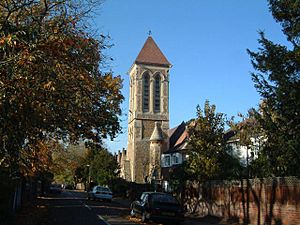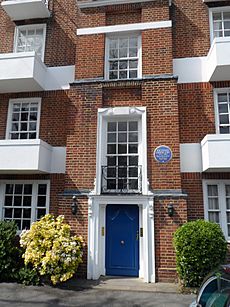East Sheen facts for kids
Quick facts for kids East Sheen |
|
|---|---|
 The Triangle and Upper Richmond Road |
|
| Area | 5.84 km2 (2.25 sq mi) |
| Population | 10,348 (East Sheen ward 2011) |
| • Density | 1,772/km2 (4,590/sq mi) |
| OS grid reference | TQ2075 |
| London borough | |
| Ceremonial county | Greater London |
| Region | |
| Country | England |
| Sovereign state | United Kingdom |
| Post town | LONDON |
| Postcode district | SW14 |
| Dialling code | 020 |
| Police | Metropolitan |
| Fire | London |
| Ambulance | London |
| EU Parliament | London |
| UK Parliament |
|
| London Assembly |
|
East Sheen, also known as Sheen, is a friendly neighbourhood in south-west London. It's part of the London Borough of Richmond upon Thames.
East Sheen has a long main street with many shops, offices, restaurants, and cafés. It's a busy place for people living in the area, and it used to be a very old part of Mortlake. This main street is called Upper Richmond Road West. It connects Richmond to Putney.
A special spot on this street is The Triangle. It's a traffic island with a war memorial and an old stone marker from 1751. This marker shows it's 10 miles (16 km) from Cornhill in the City of London.
The main train station for the area is Mortlake. It's about 300 metres north of The Triangle. East Sheen has different types of buildings, from smaller ones to taller ones. It also has many green spaces and parks. These include parts of Richmond Park, which you can enter through Sheen Gate. There's also Palewell Common, with a playground, sports fields, and tennis courts. East Sheen Common is another lovely area, owned by the National Trust. It leads to Bog Gate, another entrance to Richmond Park.
Contents
What's in a Name?
The name Sheen was first recorded around the year 950. It means "shed" or "shelters." From the 1200s, this area was known separately from Sheen (which was an older name for Richmond). It was the southern part of the Mortlake area.
A Look Back in Time
How East Sheen Grew
East Sheen used to be a small village within the larger area of Mortlake. An old book from 1792 described it as a "pleasant hamlet" with about ninety houses. It was known for its nice homes because it was close to Richmond Park and had beautiful countryside around it.
The first mentions of this specific area, separate from Mortlake, appeared in the 1200s. It was often called Westhall back then. Over the centuries, different families owned parts of the land, but they didn't have huge, fancy manor houses like some other wealthy landowners.
The Temple Grove Estate

A large estate in East Sheen called Temple Grove once belonged to Sir Abraham Cullen in the 1600s. Later, it was owned by Sir John Temple, which is how it got its name. The Temple family owned it until Henry Temple, 3rd Viscount Palmerston, who later became a famous Prime Minister, sold it in 1805.
A man named Sir Thomas Bernard bought it and rebuilt the front of the house in an old style. Later, in 1811, Reverend William Pearson bought it. He started a school for boys there called Temple Grove Preparatory School. The school moved away in 1907, and the land was then used to build houses and apartments.
How East Sheen Was Governed
In 1840, East Sheen became part of the Metropolitan Police District, which meant it had London's police force. Over time, the local government changed. From 1894, East Sheen became part of the Barnes Urban District.
Then, in 1965, a big change happened. East Sheen, along with other areas like Kew and Twickenham, joined together to form the new London Borough of Richmond upon Thames. This is the local council that governs East Sheen today.
Shopping and Business
East Sheen's main business area is along its long main street, Upper Richmond Road West. Here you'll find shops selling everything from furniture to hardware, along with many places to eat and drink. There are also supermarkets for daily needs. This street is a central spot for shopping and services, not just for East Sheen but also for nearby Mortlake.
The street has wide paths, making it easy to walk around. At its heart is The Triangle, a tree-lined island with a war memorial and an old milestone. This is where Upper Richmond Road West meets Sheen Lane. The Mortlake train station is just 300 metres north of this busy spot.
Local Churches
East Sheen is part of the church area of Mortlake with East Sheen. Besides the main Parish Church of St Mary the Virgin, there are two other important churches: Christ Church and All Saints.
Christ Church was built in the 1860s by Arthur Blomfield. It was almost finished in 1863, but the tower fell down and had to be rebuilt! It was finally completed and opened on January 13, 1864.
All Saints Church was built on land given by Major Shepherd-Cross, a Member of Parliament who lived nearby. The church was opened on All Saints' Day in 1929 by Elizabeth, Duchess of York (who later became Queen Elizabeth the Queen Mother).
East Sheen also has East Sheen Baptist Church and Parkside Christian Centre. For Catholic services, people in East Sheen go to churches in nearby Mortlake or Richmond.
Other Interesting Places
There's a special Grade II-listed air raid shelter in East Sheen. It was built before the Second World War at St Leonard's Court, a block of flats near Mortlake train station. It's a reminder of the area's history during wartime.
Famous People from East Sheen
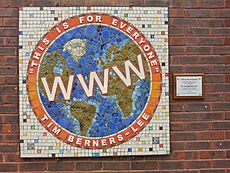
Many interesting people have lived in or have connections to East Sheen!
- Sir Tim Berners-Lee (born 1955), the amazing computer scientist who invented the World Wide Web, grew up here. He went to Sheen Mount Primary School. There's even a mosaic at Sheen Lane Centre to honour him.
- Carol Cleveland (born 1942), an actress and comedian known for her work with Monty Python, was born in East Sheen.
- Omid Djalili (born 1965), a well-known actor and comedian, lives in East Sheen.
- David Gandy (born 1980), a famous model, lives here.
- Actors Philip Glenister (born 1963) and Beth Goddard (born 1969) also live in East Sheen.
- Tom Hardy (born 1977), a popular actor, lives in the area.
- Carrie Johnson (born 1988), a conservationist and the wife of former Prime Minister Boris Johnson, grew up in East Sheen.
- Sir Trevor McDonald (born 1939), a famous broadcaster, lives in East Sheen.
- Steven Moffat (born 1961), a television writer and producer (known for Doctor Who and Sherlock), lives here with his wife, producer Sue Vertue (born 1960).
Historical Figures
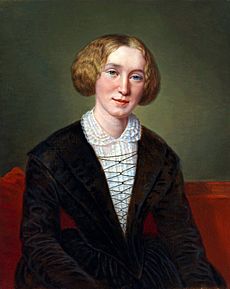
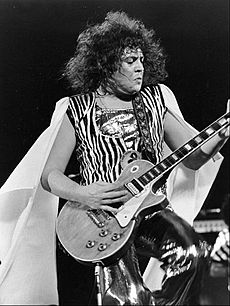
- John Partridge (1644–c.1714), an astrologer, was born in East Sheen.
- Robert Shirley, 1st Earl Ferrers (1650–1717), a nobleman and courtier, was also born here.
- Charles Grey, 2nd Earl Grey (1764–1845), who was the British Prime Minister from 1831 to 1834, rented a house in East Sheen as a country home near London.
- The famous novelist Mary Anne Evans, known as George Eliot (1819–1880), lived in East Sheen for a few months in 1855.
- Richard Dimbleby (1913–1965), a well-known radio broadcaster, lived in a flat at Cedar Court in East Sheen. There's a special blue plaque there to remember him.
- Marc Bolan (1947–1977), the lead singer of the rock band T. Rex, lived in East Sheen.
Schools in East Sheen
East Sheen has several schools for young people:
- Richmond Park Academy
- Tower House Boys' Preparatory School (a private school for boys aged 4–13)
- East Sheen Primary School (a state school on Upper Richmond Road West)
- Sheen Mount School (another state primary school on West Temple)
- Thomson House School (on Vernon Road)
Getting Around
The main train station for East Sheen is Mortlake railway station. It's about 300 metres north of The Triangle and can be reached from Sheen Lane.
You can also get around using Transport for London buses. Routes 33, 337, and 493 all travel along Upper Richmond Road West, connecting East Sheen to other parts of London.
East Sheen in Art
The Triangle in East Sheen is so special that it was even painted! There's a painting called The Triangle, Sheen Lane, East Sheen, Surrey by James Isaiah Lewis (1861–1934). You can find this painting in the Richmond upon Thames Borough Art Collection at Orleans House Gallery in Twickenham.
Images for kids
-
Prime Minister Henry Temple, 3rd Viscount Palmerston sold a large estate in East Sheen when he was young.
-
A mosaic at Sheen Lane Centre celebrating Tim Berners-Lee
-
The famous novelist George Eliot lived in East Sheen in 1855.
-
The rock musician Marc Bolan, pictured here in 1973, lived in East Sheen.
See also
 In Spanish: East Sheen para niños
In Spanish: East Sheen para niños



